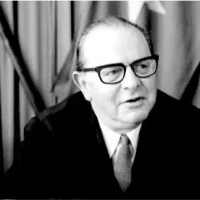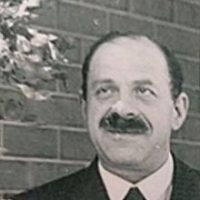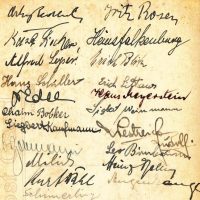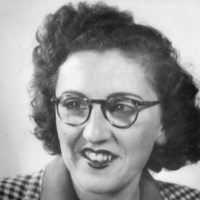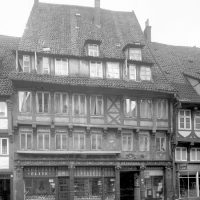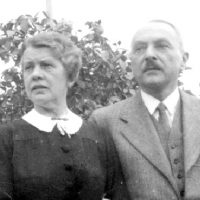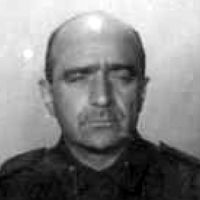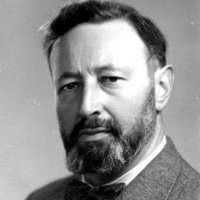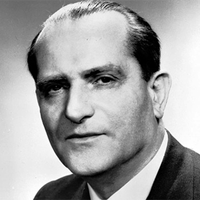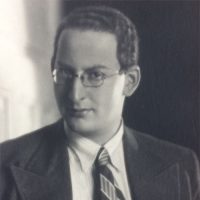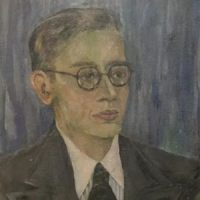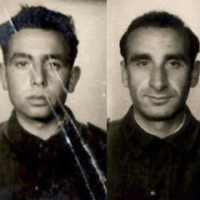Heinz Dehn, father and grandfather of the operators of this website Peter and Paul Dehn, lost seven family members in the Holocaust. Their fates will also be told, although information is sparse and photos have not survived at all.
Peter Dehn January 2024
A family is wiped out
Heinz’s father Leberecht Dehn[1] Registry office, Gdansk entry no. 3445, Mar 1, 1856. was born in Danzig on February 3, 1856. The name of his mother Adele[2] Registry office Berlin, entry no. 1717, July 17, 1897., who was born in Danzig on August 11, 1829, has survived. Her daughter Clara, born in 1851, and twins Gustav and Adolph, born in 1853, die in infancy before Leberecht’s birth. A husband for Adele is not known. Adele died in Berlin on July 15, 1897 ; she is buried in the Jewish cemetery Berlin-Weissensee.
Leberecht Dehn
At the turn of the century, Leberecht Dehn ran the “Centralbureau für Annoncen an Strassenbahnwagen[3] Berlin Adress Book of 1909, retrived via www.zlb.de, retrieved Mai 10, 2023.” (Central Bureau for Advertisements on Streetcars), most recently in his apartment at Charlottenburg, Stuttgarter Platz 9. The company was entered in the Commercial Register[4] Register notices in the Berliner Börsenzeitung no. 314, July 7, 1904. of the Royal District Court of Berlin in 1904 under No. 24541. The most recent evidence for this company is the entry in the address book of 1909. According to Heinz’s account, Leberecht has to give up his company before the 1st World War because he is seriously injured in a railroad accident. Thanks to a large compensation, he is able to buy apartment buildings in Schöneberg and Charlottenburg, which allow his family a middle-class standard of living. In address books from 1911 onward, he is listed as “owner” or “Rentier” (pensionist).
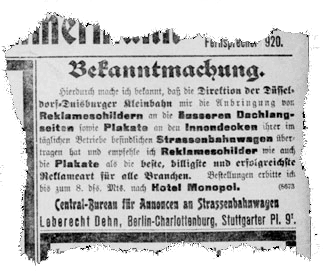
It is also known that he ran for the Liberal Party[5] Cf. newspapaer "General-Anzeiger", Nov 5, 1911. in the Charlottenburg parliament. However, he probably lost a direct election on November 5, 1911 against his competitor from the Social democratic party by a difference of 46 votes[6] Cf. newspaper "Vorwärts", Nov 6, 1911, page 3. only. The “retiree Leberecht Dehn” is appointed there on December 8, 1915 “until the end of the fiscal year” by lottery as a member of the “Income Tax Assessment Commission[7] Charlottenburg City Council Assembly. Printed matter no. 178. „Overview of the resolutions passed at the meeting on December 8, 1915, etc.“.“. In 1897 at least, he is also “Kassenrendant” (Financial Officer) in the Berlin chess club “Centrum”, which regularly organizes master tournaments.
Leberecht dies on 7 January 1928[8] Cf. newspapers "Berliner Tageblatt und Handels-Zeitung", morning edition, Jan 10, 1928, page 10.. His grave is in the Jewish cemetery[9] Cemetery index Weissensee, grave site 60614032. in Berlin Weissensee.
Leberecht’s first wife is Rosa Goldstein[10] Marriage certificate of the registry office in Gdansk no. 551/1889, Sep 15, 1884.. She is born on April 28, 1862 in Danzig , where they marry on September 15, 1884. He already lives in Berlin and Rosa moves there as well. They have two children, Leo and Alice Emmi. The marriage is divorced on December 8, 1897 by the Royal District Court I Berlin. Rosa dies of cardiac paralysis on April 5, 1941[11] Death entry no. 534, April 7, 1941. in Berlin and is buried at the Weissensee Cemetery alongside their son Leo[12] Cemetery index Weissensee, grave site 30312005..
Clara Philippson
The next sign of Leberecht Dehn’s life is his engagement to Clara Anna Philippson, born in Berlin on April 28, 1865[13] Marriage certificate no. 590, Aug 10, 1900.. This is announced by newspaper advertisement “in August 1900” at the Baltic Sea resort of Ahlbeck (Mecklenburg). They marry on August 10, 1900 in Berlin. Heinz Dehn[14] Charlottenburg registry office, entry np. 1522/1905. is born on September 23, 1905 as their only child in the parental apartment in Charlottenburg[15] Charlottenburg was an independent city until its incorporation into Greater Berlin in 1920 and is today part of the Charlottenburg-Wilmersdorf district., Stuttgarter Platz 9.
The Schöneberg tenement house has to be sold during inflation. Leberecht Dehn leaves the second property to Clara and his three children. Clara has to sell the apartment building below value[16] Cf. purchase agreement dated May 14, 1940. in April 1940 in order to pay the fascist special tax “Judenvermögensabgabe”. She writes Heinz “that I could not pay the Judenabgabe in full and also had debts with the tax office … So I had to sell the house because otherwise it would have been taken from me.” Now she is waiting for the purchase price. She writes to Heinz[17] Letter from Clara to Heinz dated 10.12.1941 (transcript for the purpose of enclosing a lawyer's letter dated Jan 27, 1958 to the Berlin compensation office). in December 1941: “I am still in the apartment (on Sybelstraße), but I have put together my dining room and bedroom because I have to rent out so much[18] "Credit note because of Kaiser Friedrichstr. 34" to Clara Dehn, Juli 31, 1941..”
Of the agreed cash portion of 59,118.12 Reichsmark of the purchase price, only 32,297.27 RM[19] In 1952, Deutsche Bank claims that account statements were destroyed during the war. Nevertheless, in 1959 - after 7 years of research and correspondence - account statements from Feb 28, 1940 to July 8, 1942 emerged. are payed. Further possessions, including securities, jewelry and the furnishings[20] Annex to the affidavit of Heinz Dehn, No. 252/57 of the notary Jackier of July 25, 1957. of her last four-room apartment at Sybelstraße 54, estimated by Heinz at 13,750 Reichsmark are expropriated by the Nazi government and turned into money for war financing.
Clara Dehn is deported to Terezin on August 31, 1942 with transport I/55 No. 5703. She is transferred from there to the Treblinka extermination camp[21] Cf. Gedenkbuch Berlin, Holocaust databases Yad Vashem, holocaust.cz etc. on September 29, 1942 (Transport Bs 327) and murdered there. In her memory, a Stolperstein was laid on May 12, 2023 – in front of the house at Sybelstraße 54 in Berlin Charlottenburg.
Heinz’s siblings Leo and Alice Emmi
The older of Rosa and Leberecht’s two children is Leo, born in Berlin on October 29, 1885. During World War I, he served as a volunteer[22] Nominal Rolls of the Kingdom of Bavaria, Vol. 18039. in Army Aviation Park 6, taking part in several position battles, among others, and was promoted to sergeant in 1916.
In 1923 his name appears in the Berlin Commercial Register – in the entry of the company Dehn & Wengel[23] Commercial register entry no. 30017/1923., Textil-Exportvertretungen GmbH. In the 1930s, he works as a property manager, with his half-brother Heinz assisting him at times.
Leo dies on September 2, 1936[24] Death entry no. 387, Sep 3, 1936., at the age of only 50. Heinz reports this to the registry office and names Rigaer Straße 88[25] Cemetery index Weissensee, grave site 30312005. in Berlin-Friedrichshain as the place of death. Leo had died there at the door of an apartment when he wanted to collect rent, according to Heinz. He is buried in Weissensee.
Alice Emmi Dehn[26] Birth entry no. 2197, Oct 29, 1888. is born in Berlin on October 22, 1888, the second child of Leberecht and Rosa. She works in a publishing house before marrying Otto Stern[27] Marriage certificate no.209, Feb 28, 1920. (born November 9, 1877 in Siegburg near Cologne) on February 28, 1920. They live in Seydelstrasse in Berlin-Moabit until at least 1936. They are forced to move into a “Judenwohnung” at Altonaer Straße 6 (today: Hansaviertel). Until shortly before their deportation, they struggle to maintain their fur trade business in order to earn a modest living.
On January 19, 1942 they are deported to the Riga ghetto, the transport number is IX/5676. On October 1, 1944 Alice Emmi is sent to the death camp Stutthof[28] Cf. Mapping the Lives, retrieved May 10, 2023., where she is said to have “died” on January 8, 1945. Otto Stern probably becomes a victim of the fascist mass murders in the Riga ghetto. Alice Emmi and Otto are commemorated by entries in the “[Window of Remembrance” inaugurated in 2018 in the entrance of the Hansaplatz subway station in Berlin-Tiergarten opposite Altonaer Straße 6.
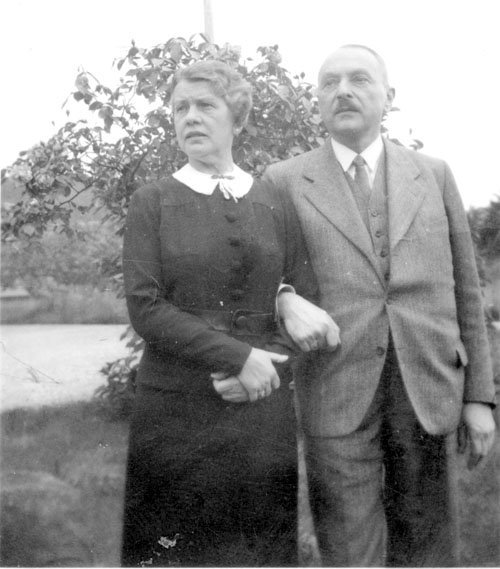
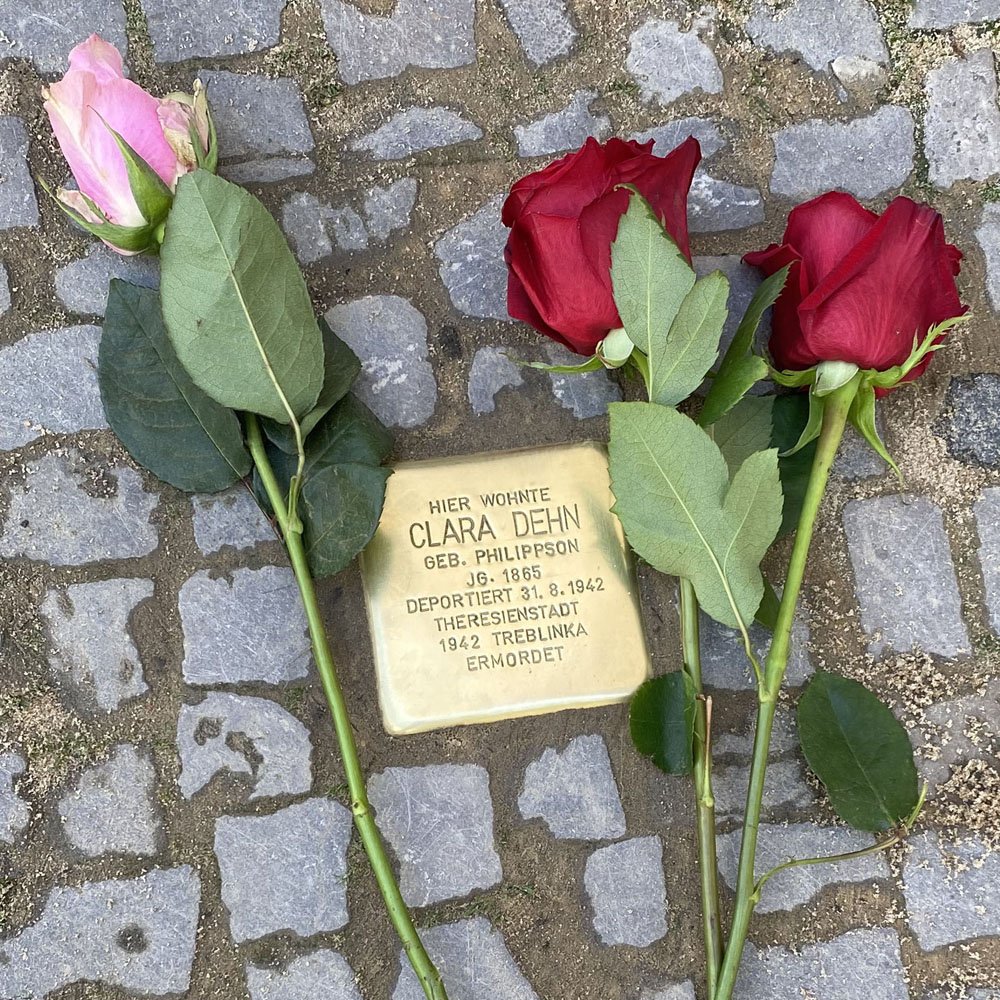
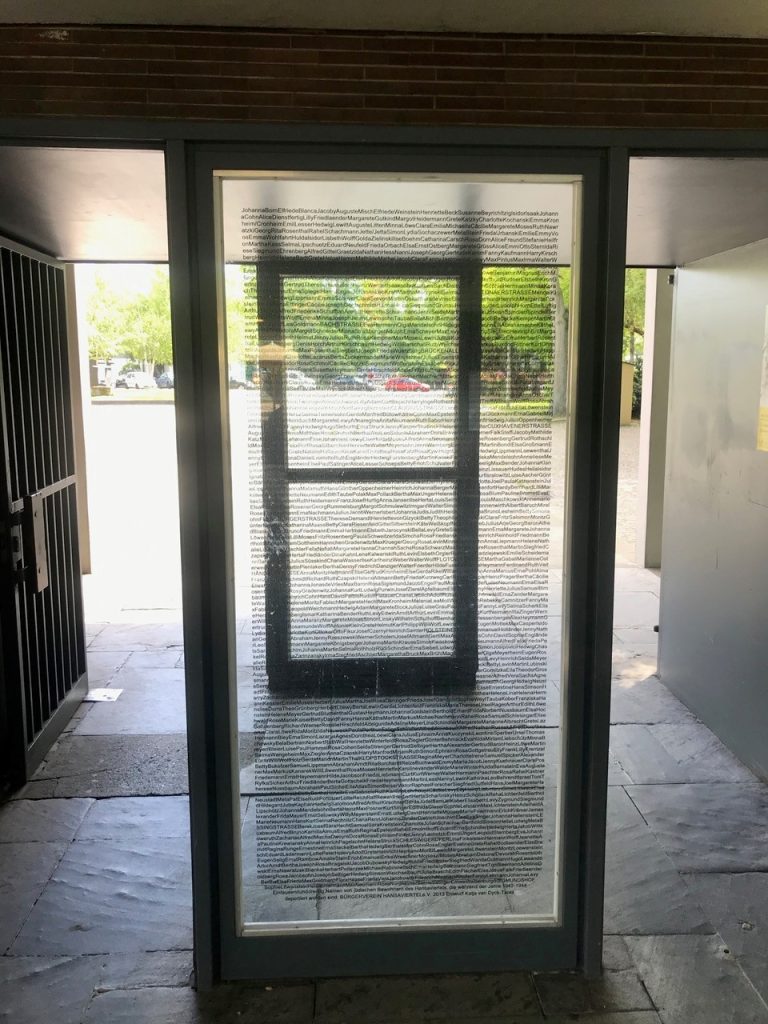
Governemental looting
On February 23, 1942, the Tiergarten city administration meticulously lists on five pages the property that Alice Emmi and Otto had to leave behind in their last Moabit apartment. The value is taxed[30] Valuation record dated Feb 23, 1942. at 510 Reichsmark. The cover page handwritten notes the tenants as “deported”. “Due to the transfer of his residence to a foreign country” and the loss of citizenship, all their property “was forfeited to the Reich on 19.1.1942.” Due to the racist mass plundering, this also includes a life insurance policy of the Sterns worth 99.19 Reichsmark. This is duly reported by the Grossdeutsche Feuerbestattung V.V.a.G.[31] Letter from the insurance company, May 22, 1943. zu Berlin to the Oberfinanzpräsident Berlin-Brandenburg (Chief Finance President Berlin Brandenburg). The abbreviation “a.G.” officially stands for “mutual”, but has lost its euphony. The state-sanctioned theft of Jewish property[32] Consists of the amounts RM 4,420.45 (account Otto Stern), RM 8,339.30 (savings book Alice Stern), RM 510.00 (inventory of the apartment), RM 99.19 (life insurance). formally adds up to 13,368.99 Reichsmark.
A dispute between Deutsche Bank and the “Vermögensverwertungsstelle” of the Oberfinanzpräsident about the bank assets of the “moved unknown” Sterns dates back to November 1943. Before paying out the savings account claimed by the state in Alice’s name, the bank expects the savings book to be presented or a declaration of liability. This is not a form of resistance, but on the contrary only a reassurance, because the bank does not want to take responsibility for the crime or even be liable. Part of the authority’s reference number is the code number of the deportation[33] Brandenburg State Archives, Rep 36A Nr. 37216. IX/5676.
Heinz’s first wife Margot Dehn and their children
On April 1, 1937, Heinz Dehn marries Margot Bick[34] Marriage entry of the registry office Charlottenburg 1 no. 279, Apr 1, 1937. (born October 19, 1912, a kindergarten teacher from Charlottenburg. Their daughter Monika Ruth[35] Birth entry of the Wilmersdorf registry office no. 1804, Sep 24, 1937. (born on September 22, 1937) and son Denny[36] Birth entry of the Wilmersdorf registry office no. 1641 vom Mar 15, 1940. (born on March 12, 1940) were born.
After his imprisonment in a concentration camp, Heinz escapes to England with the help of Jewish organizations – just two weeks before Hitler starts the world war. However, he has to leave his family behind in Berlin. He never saw his son, because Denny was born after Heinz’s departure. Knowing of the impending trip and aware that the card will pass censorship in Nazi Germany, Margot writes a final card to Heinz in Australia:

“My good man! I want to write to you quickly before our journey to tell you how we are feeling. Oh darling, I don’t know what else to tell you. Pray for us all, especially for the children. Have strength and always think of your very loving and unhappy wife. A thousand kisses from the children and from Mum too.”
Margot Dehn wrote the last postcard to her husband Heinz a few days before she, her children and her mother were deported to the Riga ghetto by the Nazis. They were murdered in a forest near the Latvian capital. Source: Dehn family archive.
The family and Margot’s mother Dora Hartmann (née Warschauer, widowed Bick) are deported to Riga on the 21st Eastern Transport[37] Transport list no. 73 to 75. on October 19, 1942 – on Margot’s 30th birthday – from the Berlin-Moabit freight station. Of the 962 Berlin Jews of all ages, including 209 children, only 81 able-bodied men reach the Riga ghetto. All the others were shot on the day of arrival[38] Yad Vashem, Database of deportations, retrieved May 10, 2023., October 22, 1942, in the forests of Rumbula or Bikernieki near the arrival station Skirotava near Riga. Their bodies are buried in a mass grave[39] Cf. Alliance German Riga Committee, retrieved May 10, 2023.. Stolpersteine commemorate them in the Dahlmannstraße 10 in Berlin-Charlottenburg.
The stamps show that Margot’s postcard reaches Sydney on March 19, 1943, and is forwarded to the Tatura internment camp and from there to the Australian Army, where Heinz has been serving since mid-November 1942. When Heinz holds the card in his hands, his family has been murdered. But he knows nothing about it.
Margot’s siblings

Margot’s older brother Heinz Bick, born on April 8, 1906 in Kosten (Koscian, Poland), probably turned his back on Germany already during the “golden” twenties. He marries[40] Marriage entry No. 135 of Dec 18, 1931, Mexico DF, refers to Heinz's mother Dora, among others. Angela Trejo in Mexico in 1931. Further details are not known. Margot’s sister and maid of honor Resy Bick, born in Kosten on January 24, 1908, manages to escape to Chile before the war begins. There she dies in Santiago de Chile on March 18, 1963, after a long illness due to nazi persecution. Half-sister Ilse Friedel Hartmann was born in Breslau on March 6, 1918. She survives the Nazi period in illegality and later also travels to Santiago de Chile[41] Cf. restitution files Berlin B Rep 025-04-598-61 bis -600-61; WGA 45 392-62, WGA 45 644-61, WGA 45 1947-63. with her husband Erich Blumenthal, where she dies on September 21, 1995.
Addendum: Reparation, compensation?
In the estate of Heinz Dehn and his second wife Ida, a box full of files is found. These essentially concern the procedures for “compensation” and “reparation” for the Nazis’ crimes against them and their families. The offices and courts concerned with the implementation of the relevant laws in West Berlin and the Federal Republic often try to squeeze claims that have been filed. Claimants must provide evidence down to the last detail, such as the value of jewelry, valuables, accounts, home furnishings, etc. that the German state had stolen from Jews. In many cases, however, evidence is not available because it was destroyed during the war. In addition, many applicants who had survived the Nazi years abroad naturally have difficulties in obtaining the desired documents in time. Requested affidavits have to be sworn at German consulates – which do not exist everywhere. Missing documents and – due to the international back and forth – missed deadlines are interpreted by the authorities to the disadvantage of the applicants. For example, a Berlin office demands proof from Heinz Dehn that there had been no press releases in Australia about the relevant German laws and deadlines. Inadequate regulations, bureaucracy, harassment of the authorities again (or: still?) riddled with Nazis have particularly burdened the Nazi victims living abroad and led to sometimes decades-long – for the claimants exhausting – proceedings for pensions, compensation payments, etc.. This basically affects many of the Nazi victims. The way the authorities dealt with the Nussbaum family and Ernst Friedlich is exemplary.
Is it even possible to “make amends” for mass murder or
to “compensate” for systematic robbery by the state?
Note: Unless otherwise stated, the sources mentioned are part of the Dehn family archive.
Footnotes
show
- [1]↑Registry office, Gdansk entry no. 3445, Mar 1, 1856.
- [2]↑Registry office Berlin, entry no. 1717, July 17, 1897.
- [3]↑Berlin Adress Book of 1909, retrived via www.zlb.de, retrieved Mai 10, 2023.
- [4]↑Register notices in the Berliner Börsenzeitung no. 314, July 7, 1904.
- [5]↑Cf. newspapaer "General-Anzeiger", Nov 5, 1911.
- [6]↑Cf. newspaper "Vorwärts", Nov 6, 1911, page 3.
- [7]↑Charlottenburg City Council Assembly. Printed matter no. 178. „Overview of the resolutions passed at the meeting on December 8, 1915, etc.“.
- [8]↑Cf. newspapers "Berliner Tageblatt und Handels-Zeitung", morning edition, Jan 10, 1928, page 10.
- [9]↑Cemetery index Weissensee, grave site 60614032.
- [10]↑Marriage certificate of the registry office in Gdansk no. 551/1889, Sep 15, 1884.
- [11]↑Death entry no. 534, April 7, 1941.
- [12]↑Cemetery index Weissensee, grave site 30312005.
- [13]↑Marriage certificate no. 590, Aug 10, 1900.
- [14]↑Charlottenburg registry office, entry np. 1522/1905.
- [15]↑Charlottenburg was an independent city until its incorporation into Greater Berlin in 1920 and is today part of the Charlottenburg-Wilmersdorf district.
- [16]↑Cf. purchase agreement dated May 14, 1940.
- [17]↑Letter from Clara to Heinz dated 10.12.1941 (transcript for the purpose of enclosing a lawyer's letter dated Jan 27, 1958 to the Berlin compensation office).
- [18]↑"Credit note because of Kaiser Friedrichstr. 34" to Clara Dehn, Juli 31, 1941.
- [19]↑In 1952, Deutsche Bank claims that account statements were destroyed during the war. Nevertheless, in 1959 - after 7 years of research and correspondence - account statements from Feb 28, 1940 to July 8, 1942 emerged.
- [20]↑Annex to the affidavit of Heinz Dehn, No. 252/57 of the notary Jackier of July 25, 1957.
- [21]↑Cf. Gedenkbuch Berlin, Holocaust databases Yad Vashem, holocaust.cz etc.
- [22]↑Nominal Rolls of the Kingdom of Bavaria, Vol. 18039.
- [23]↑Commercial register entry no. 30017/1923.
- [24]↑Death entry no. 387, Sep 3, 1936.
- [25]↑Cemetery index Weissensee, grave site 30312005.
- [26]↑Birth entry no. 2197, Oct 29, 1888.
- [27]↑Marriage certificate no.209, Feb 28, 1920.
- [28]↑Cf. Mapping the Lives, retrieved May 10, 2023.
- [29]↑The Bürgerverein Hansaviertel e.V. initiated the Window of Remembrance, retrieved on Aug 2, 2023.
- [30]↑Valuation record dated Feb 23, 1942.
- [31]↑Letter from the insurance company, May 22, 1943.
- [32]↑Consists of the amounts RM 4,420.45 (account Otto Stern), RM 8,339.30 (savings book Alice Stern), RM 510.00 (inventory of the apartment), RM 99.19 (life insurance).
- [33]↑Brandenburg State Archives, Rep 36A Nr. 37216.
- [34]↑Marriage entry of the registry office Charlottenburg 1 no. 279, Apr 1, 1937.
- [35]↑Birth entry of the Wilmersdorf registry office no. 1804, Sep 24, 1937.
- [36]↑Birth entry of the Wilmersdorf registry office no. 1641 vom Mar 15, 1940.
- [37]↑Transport list no. 73 to 75.
- [38]↑Yad Vashem, Database of deportations, retrieved May 10, 2023.
- [39]↑Cf. Alliance German Riga Committee, retrieved May 10, 2023.
- [40]↑Marriage entry No. 135 of Dec 18, 1931, Mexico DF, refers to Heinz's mother Dora, among others.
- [41]↑Cf. restitution files Berlin B Rep 025-04-598-61 bis -600-61; WGA 45 392-62, WGA 45 644-61, WGA 45 1947-63.
